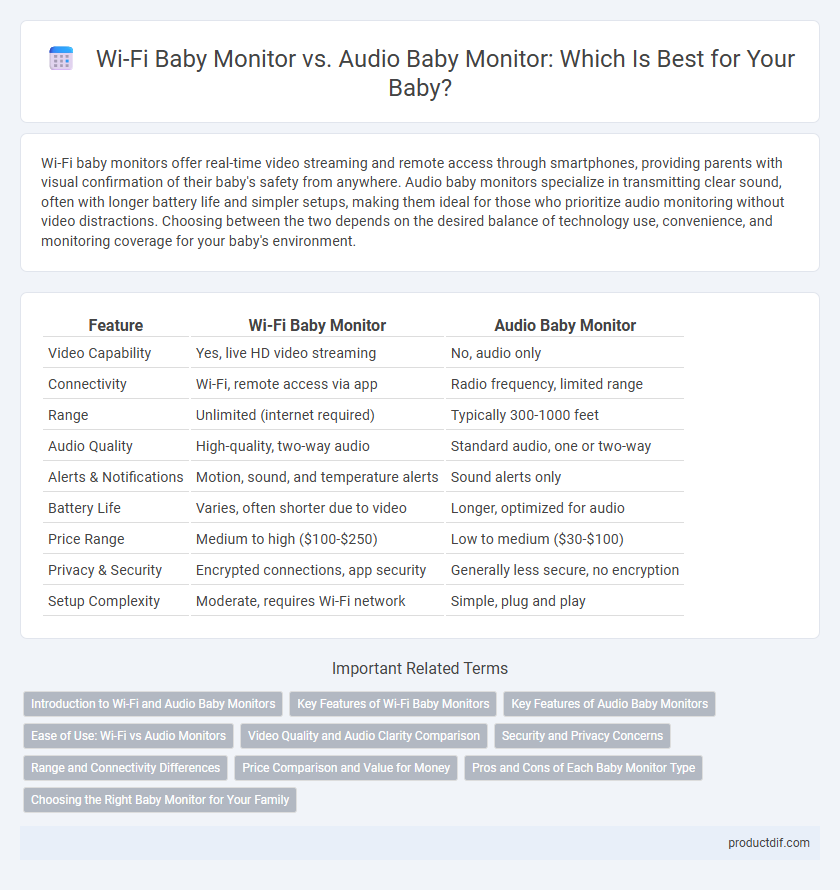Wi-Fi baby monitors offer real-time video streaming and remote access through smartphones, providing parents with visual confirmation of their baby's safety from anywhere. Audio baby monitors specialize in transmitting clear sound, often with longer battery life and simpler setups, making them ideal for those who prioritize audio monitoring without video distractions. Choosing between the two depends on the desired balance of technology use, convenience, and monitoring coverage for your baby's environment.
Table of Comparison
| Feature | Wi-Fi Baby Monitor | Audio Baby Monitor |
|---|---|---|
| Video Capability | Yes, live HD video streaming | No, audio only |
| Connectivity | Wi-Fi, remote access via app | Radio frequency, limited range |
| Range | Unlimited (internet required) | Typically 300-1000 feet |
| Audio Quality | High-quality, two-way audio | Standard audio, one or two-way |
| Alerts & Notifications | Motion, sound, and temperature alerts | Sound alerts only |
| Battery Life | Varies, often shorter due to video | Longer, optimized for audio |
| Price Range | Medium to high ($100-$250) | Low to medium ($30-$100) |
| Privacy & Security | Encrypted connections, app security | Generally less secure, no encryption |
| Setup Complexity | Moderate, requires Wi-Fi network | Simple, plug and play |
Introduction to Wi-Fi and Audio Baby Monitors
Wi-Fi baby monitors provide real-time video and audio streaming through wireless internet, allowing parents to monitor their baby remotely via smartphones or tablets. Audio baby monitors transmit sound only, using radio frequencies to offer clear audio alerts without video capabilities. Choosing between Wi-Fi and audio baby monitors depends on the desired level of connectivity, video access, and security preferences.
Key Features of Wi-Fi Baby Monitors
Wi-Fi baby monitors offer high-definition video streaming and remote access via smartphone apps, enabling parents to check on their baby anytime and anywhere with an internet connection. These monitors often include advanced features such as two-way audio, night vision, temperature sensors, and motion alerts for enhanced safety and convenience. Unlike audio-only monitors, Wi-Fi baby monitors provide visual monitoring and integration with smart home devices to deliver comprehensive baby monitoring solutions.
Key Features of Audio Baby Monitors
Audio baby monitors feature real-time sound transmission with high sensitivity microphones that capture subtle noises like breathing and soft cries. They often provide extended battery life and long-range connectivity, ensuring parents can monitor their baby across different rooms without interference. Many models include adjustable volume controls and two-way communication, allowing caregivers to soothe their baby remotely.
Ease of Use: Wi-Fi vs Audio Monitors
Wi-Fi baby monitors offer remote access through smartphones, enabling parents to check on their baby from anywhere with an internet connection. Audio baby monitors provide straightforward operation with simple volume controls and no need for app setup, making them ideal for quick, reliable use. The choice hinges on whether parents prioritize mobile convenience or uncomplicated, instant audio monitoring.
Video Quality and Audio Clarity Comparison
Wi-Fi baby monitors offer superior video quality with high-definition streaming and real-time visuals, enabling parents to closely observe their baby's movements and surroundings. Audio baby monitors prioritize clear sound transmission but lack visual feedback, which limits monitoring to audio cues only. Enhanced audio clarity in audio monitors can detect subtle sounds better, but Wi-Fi monitors combine both crisp video and reliable audio for comprehensive baby monitoring.
Security and Privacy Concerns
Wi-Fi baby monitors offer remote access and video streaming but pose higher security risks due to potential hacking and data breaches, making strong encryption and regular firmware updates essential. Audio baby monitors use simpler transmission methods, reducing exposure to cyber threats but lacking advanced privacy controls and remote monitoring features. Choosing between the two depends on prioritizing convenience with robust security protocols or opting for a lower-risk audio-only solution.
Range and Connectivity Differences
Wi-Fi baby monitors offer extended range and remote accessibility through internet connection, enabling parents to monitor their baby from anywhere using a smartphone app. Audio baby monitors rely on direct radio frequency transmission with limited range, typically up to 1,000 feet in open spaces, and do not require internet access. Wi-Fi monitors may experience connectivity issues due to network interference, while audio monitors provide more stable signals within their restricted coverage area.
Price Comparison and Value for Money
Wi-Fi baby monitors typically cost between $70 and $200, offering video streaming and remote access, while audio baby monitors range from $20 to $80, providing basic sound-only monitoring. Despite the higher price, Wi-Fi monitors deliver enhanced features such as real-time video, motion alerts, and two-way communication, offering greater value for tech-savvy parents seeking comprehensive monitoring. Audio monitors remain a budget-friendly choice for those prioritizing simplicity and cost-effectiveness without video functionality.
Pros and Cons of Each Baby Monitor Type
Wi-Fi baby monitors offer high-resolution video streaming and remote access via smartphones, enabling parents to visually check on their baby from anywhere, but they may present privacy concerns and rely heavily on a stable internet connection. Audio baby monitors provide clear sound transmission with longer battery life and less interference, offering simplicity and reliability without exposing video footage, yet they lack the visual component that some parents prefer for peace of mind. Choosing between these types depends on the balance of desired features such as video visibility versus audio clarity, security preferences, and connectivity reliability.
Choosing the Right Baby Monitor for Your Family
A Wi-Fi baby monitor offers real-time video streaming and remote access through smartphones, enhancing security and convenience for tech-savvy parents. Audio baby monitors provide reliable sound detection with lower costs and minimal setup, ideal for families prioritizing simplicity and budget. Selecting the right baby monitor depends on your family's lifestyle, communication preferences, and desired features such as video capability or extended range.
Wi-Fi Baby Monitor vs Audio Baby Monitor Infographic

 productdif.com
productdif.com